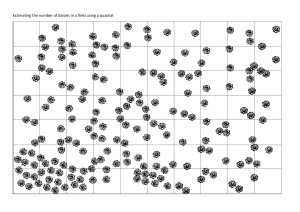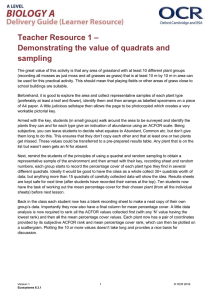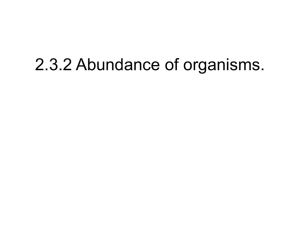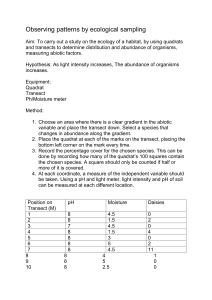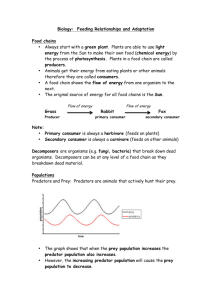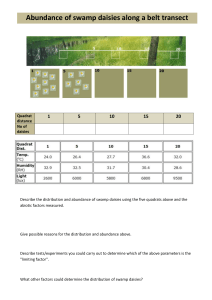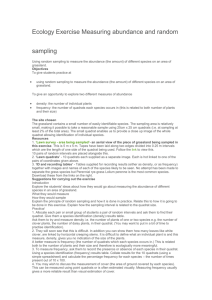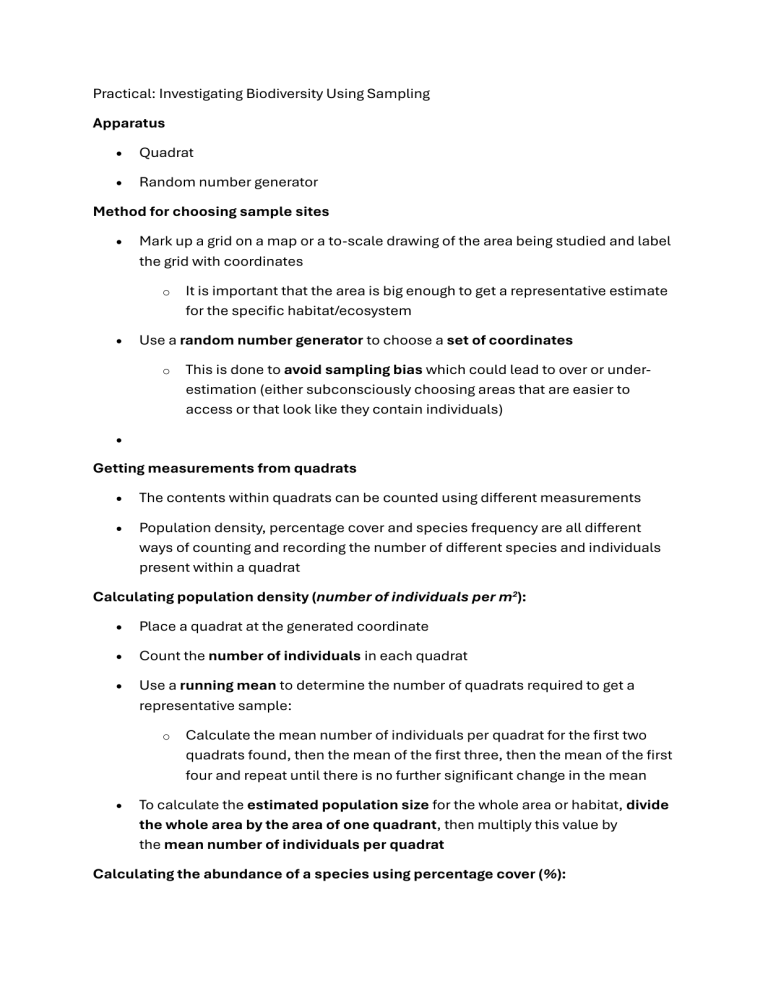
Practical: Investigating Biodiversity Using Sampling Apparatus • Quadrat • Random number generator Method for choosing sample sites • Mark up a grid on a map or a to-scale drawing of the area being studied and label the grid with coordinates o • It is important that the area is big enough to get a representative estimate for the specific habitat/ecosystem Use a random number generator to choose a set of coordinates o This is done to avoid sampling bias which could lead to over or underestimation (either subconsciously choosing areas that are easier to access or that look like they contain individuals) • Getting measurements from quadrats • The contents within quadrats can be counted using different measurements • Population density, percentage cover and species frequency are all different ways of counting and recording the number of different species and individuals present within a quadrat Calculating population density (number of individuals per m2): • Place a quadrat at the generated coordinate • Count the number of individuals in each quadrat • Use a running mean to determine the number of quadrats required to get a representative sample: o • Calculate the mean number of individuals per quadrat for the first two quadrats found, then the mean of the first three, then the mean of the first four and repeat until there is no further significant change in the mean To calculate the estimated population size for the whole area or habitat, divide the whole area by the area of one quadrant, then multiply this value by the mean number of individuals per quadrat Calculating the abundance of a species using percentage cover (%): • Usually used for plants • Place a grid quadrat (a square frame split into 100 smaller squares) at this coordinate o • Each square of a grid quadrat is equivalent to 1% cover Count the number of squares in each quadrat within which the species occupies over half the square o If 30 squares contain the species, the percentage cover is 30% o This method is subjective and therefore the same person should make the estimate for all samples to control this variable Calculating the abundance of a species using frequency (%): • Place a frame quadrat at multiple coordinates generated • Count the number of quadrats that contain the species o If 3 out of 10 quadrats contain the species the frequency is 30% Interpreting results from quadrats • The results from the quadrats can be used to calculate the predicted frequency and density of a species within an area • Species density indicates how many individuals of that species there are per unit area • • o The number of individuals counted across all quadrats is divided by the total area of all the quadrats o For example, if 107 bluebells were found across 50 quadrats that are 1m2 each the species density would be 107/50 = 2.14 individuals per m2 It can sometimes be difficult to count individual plants or organisms. When this is the case percentage cover of the species within the quadrat can be estimated instead o The quadrat is divided into 100 smaller squares. The number of squares the species is found in is equivalent to its percentage cover in that quadrat o For example, if grass is found in 89 out of 100 squares in the quadrat then it has a percentage cover of 89% Species frequency is the probability that the species will be found within any quadrat in the sample area o The number of quadrats that the species was present in is divided by the total number of quadrats and then multiplied by 100 o For example, if bluebells were found in 18 out of 50 quadrats the species frequency would be (18/50) x 100 = 36% How to estimate percentage cover of one or more species using a quadrat Limitations of using quadrats • Quadrats and transects can only be used for sessile and immobile species (eg. plants and slow-moving animals) • Some species can be counted to find their abundance but others that are very small or in high numbers require abundance to be calculated using percentage cover or frequency techniques o • The frequency technique shows how common a species is but it does not give information on the estimated number of individuals or the size of the population Percentage cover and frequency, when used together, give a good picture of the distribution of a species o If a species had a high mean percentage cover but a low frequency it would suggest the species lives in groups in preferred areas of the habitat o This can be used to answer questions such as: does the species prefer light or dark and wet or dry areas etc. The mark-release-capture method: estimating population sizes of mobile animals • The two sampling methods described above are only useful for nonmotile (sessile) organisms • Different methods are required for estimating the number of individuals in a population of motile animals o • The mark-release-capture method is used For a single species in the area: o The first large sample is taken. As many individuals as possible are caught, counted and marked in a way that won’t affect their survival e.g. if studying a species of beetle, a small amount of brightly coloured nontoxic paint can be applied to their carapace (shell) o The marked individuals are returned to their habitat and allowed to randomly mix with the rest of the population o When a sufficient amount of time has passed another large sample is captured o The number of marked and unmarked individuals within the sample are counted o The proportion of marked to unmarked individuals is used to calculate an estimate of the population size o The formula for the calculation is: N = (n1 × n2) ÷ m2 • o Where: N = population estimate n1 = number of marked individuals released n2 = number of individuals in the second sample (marked and unmarked) m2 = number of marked individuals in the second sample Worked example Scientists wanted to investigate the abundance of leafhoppers in a small grassy meadow. They used sweep nets to catch a large sample of leafhoppers from the meadow. Each insect was marked on its underside with non-toxic waterproof paint and then released back into the meadow. The following day another large sample was caught using sweep nets. Use the figures below to estimate the size of the leafhopper population in this meadow. • No. caught and marked in first sample (n1) = 236 • No. caught in second sample (n2) = 244 • No. of marked individuals in the second sample (m2) = 71 Step One: Write out the equation and substitute in the known values N = (n1 × n2) ÷ m2 N = (236 × 244) ÷ 71 Step Two: Calculate the population size estimate (N) N = 57,584 ÷ 71 N = 811 Results from mark-release-capture • When using the mark-release-capture method, there are a few assumptions that have to be made: o The marked individuals are given sufficient time to disperse and mix back in fully with the main population o The marking doesn't affect the survival rates of the marked individuals (e.g. doesn't make them more visible and therefore more likely to be predated) o The marking remains visible throughout the sampling and doesn't rub off o The population stays the same size during the study period (i.e. there are no significant changes in population size due to births, deaths or migrations into or out of the main population)
